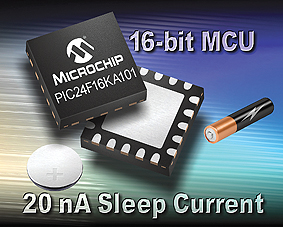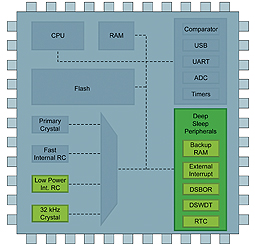New techniques are pushing embedded power management beyond Sleep mode, as Jason Tollefson of Microchip Technology Inc., explains
With sleep modes no longer able to deliver the energy economies which can support a new generation of products with decade-long battery life-times, or keep pace with the surge in ‘green’ demands, microcontroller manufacturers are turning to new techniques to take embedded power management beyond the conventional Sleep mode.
Recently, for example, microcontroller (MCU) manufacturers have begun to use electronic ‘switches’ to completely remove power from some parts of the chip when they are not in use; voltage supervisory circuits have also advanced so that they can deliver continuous control whilst drawing the most minimal amount of battery power. By exploring these emerging technologies, some insight can be gained into how they can be implemented for maximum effect.
Sleep shows its age
Traditionally, the MCU’s Sleep mode has been the embedded designer’s most useful power-management tool. But Sleep mode has been around for many years and its age is beginning to

show: It can no longer be relied on to reach the continuously moving benchmark for power minimization which is fundamental to new generations of embedded products.
One of the reasons for this is that, over the years, microcontrollers have become more complex with the integration of more features and peripherals. With each increase in complexity, the microcontroller gains additional process nodes, all of which can contribute to energy leakage within the system. Add to this the emergence of products which require battery lifetimes of ten years or more, in applications such as smart utility meters, smoke detectors, as well as increasing legislation to control power consumption and it becomes clear that the traditional Sleep mode simply cannot deliver sufficient power savings.
Deeper than sleep
To offset the effects of increasing complexity and smaller process geometries, MCU manufacturers have introduced new modes for driving down the power draw. Although the names may vary, such as Standby, STOP2, LPM5, or Deep Sleep, their purpose is the same: They are intended to drive down the microcontroller’s need for power beyond the efficiencies achieved by Sleep mode.
All Deep Sleep techniques work by using embedded software-controlled switches to remove power from significant areas of the microcontroller. Powering off the transistors in areas of the chip removes transistor leakage and therefore significantly extends battery life. In Deep Sleep mode, the green circuits in Figure 2 will continue to draw power, whilst the other circuits will have their power removed.
Not all manufacturers achieve the same level of power-savings from Deep Sleep. Typically most achieve an 80% reduction in sleep current, but some MCUs now achieve Deep Sleep currents as low as 20 nA. The combination of low currents in Deep Sleep mode, with batteries which achieve low self-discharge rates, can add years to the battery-life of an application.
The Deep Sleep trade-off
Of course, every new advance brings a new trade-off and, for Deep Sleep mode, this trade-off is a slower start-up time.
Typically, it takes between 1-10 µs for an MCU to wake from standard Sleep mode but, depending on the manufacturer, an MCU can take 300 µs-3 ms when waking from Deep Sleep. The longer start-up is needed for the power-up sequences to terminate and the on-chip regulators to stabilize. Waking from a Deep Sleep mode is very similar to a full Power-on Reset.

Another significant difference is that most implementations of Deep Sleep remove power from the RAM, peripheral registers and I/O, whilst in standard Sleep mode, execution starts exactly from where it stopped. Deep Sleep modes need the program context to be restored from a non-volatile memory source, such as Flash or EEPROM, or from small areas of back-up RAM that are not powered down in Deep Sleep. Since current is needed for code to be executed to restore the MCU to its pre-Deep Sleep state, there is a power penalty for waking from Deep Sleep.
Wake-up call
Waking a MCU from Deep Sleep is different to waking it from Sleep mode. Traditional Sleep mode has a number of ways to wake the MCU, such as interrupts, timers, communication reception, end of ADC conversion and supply-voltage changes. Some, but not all, of these wake-up sources have been included by MCU manufacturers in their Deep Sleep modes. Sources of wake-up available in Deep Sleep mode can include interrupts, reset pins, power-on reset, real-time clock alarms, watchdog timers and brownout detection. What is missing here is wake-up from communication reception and end of ADC conversion. Since these portions of the device do not have power, those wake-up features cannot be supported in Deep Sleep mode. As different manufacturers may choose to use different implementations for wake-up, it is important to review the wake-up capabilities provided by different microcontroller families.
Some vendors, for example, only exit Deep Sleep by the assertion of the RESET pin. This works for applications that have an “on” button and consumes no additional current. Pressing the button, wakes the application from Deep Sleep, restores its state and the product is ready to go. This works for applications such as thermometers and handheld devices and can also be used to lengthen the shelf-life of battery-powered products, because they can be shipped them in the Deep Sleep state.
Other vendors use a more complete system implementation and have included more flexibility by adding real-time clock and calendar functions. These allow the application to be autonomous and may add as little as 500 nA to the Deep Sleep current. Rather than waiting for a button to be pressed, the clock’s alarm wakes the device. This is important for applications such as smoke detectors which must wake two or three times per minute to sample the air quality, or for a battery-powered sensor that wakes a few times per day to transmit data.
Dramatically longer battery lifetimes can be achieved by matching each application to specific Deep Sleep wake-up features,
End-of-life
Even though Deep Sleep increases battery lifetime there will undoubtedly still be a time when the battery reaches its end-of-life and the risk of improper operation increases.
Typically, supervisory circuits such as Brownout Reset (BOR) circuits and Watchdog Timers (WDTs) are used to protect against this. Brownout circuits can detect if the battery output is too low for safe operation and force the application into a safe state. Watchdog timers offer similar protection against errant code execution, if the MCU attempts to execute in unsafe voltage or frequency conditions. The main problem with these circuits is their current consumption, which can typically be as high as 5-50 µA. In a MCU which aims for benchmark energy-consumption by using Deep Sleep mode, the power consumed by these traditional solutions is unacceptable.
The latest MCUs overcome this by introducing a number of lower-current BOR and WDT circuits, specifically designed for Deep Sleep mode.
Known as Deep Sleep BOR (DSBOR) or Zero-Power BOR, these brownout circuits tradeoff accuracy in return for current consumption which can be as low as 45 nA. This not only protects the product at the end of battery life, but also protects against momentary power loss due to battery holder flex, which is common in battery-powered systems. The way in which low-current BOR is implemented varies between vendors: some may be turned off whilst other are permanently on. As not all MCU manufacturers provide a BOR for Deep Sleep it is important to check the MCU for its compatibility with each application.
A few vendors have also reduced watchdog-timer currents in MCUs with Deep Sleep achieving a current draw which can be as low as 400 nA.
These improvements in current consumption mean that both supervisor circuits can now remain powered while in Deep Sleep, with a combined current consumption as low as 445 nA. This achieves a 99% lower current consumption than in the previous generation of MCUs. By using the equation shown above, the break-even time (Tbe) with both supervisor circuits is shown to be only 5.9 seconds. The current consumption of these new supervisory circuits, therefore, enables safer operation for a whole range of applications that sleep for longer than 6 seconds.
Despite these trade-offs there are many applications that can benefit from Deep Sleep. The difficulty, of course, is in determining which applications should implement Deep Sleep and which should not. The following simple equation can answer this question:
Tbe = ((Tinit*Idd)+(Tpor*Ipor))/(Ipdslp-Ipdds)
Where:
Tbe = Breakeven Time where charge in Sleep equals charge in Deep Sleep
Tinit = Initialisation time to resume full-power operation
Idd = Current consumed during run mode
Tpor = Time required for Power-on Reset
Ipor = Power-on Reset Current (including regulator stabilisation capacitor current, if present)
Ipdslp = Static Current in Sleep Mode
Ipdds = Static Current in Deep Sleep Mode
(Equation courtesy of Microchip: Application Note AN1267)
The above equation models the charge in Sleep and Deep Sleep. The break-even time, Tbe, is the point at which the charge in each mode is equal. Deep Sleep provides the maximum benefit beyond Tbe, as shown in the following example.
Assume that the MCU with Deep Sleep mode has the following characteristics:
Initialisation execution time (Tinit) = 200 µs
Current during execution (Idd) = 400 µA
Power-on Reset Time (Tpor) = 600 µs
Current in POR (Ipor) = 30 mA*
Current in Sleep mode (Ipdslp) = 3.5 µA
Current in Deep Sleep mode (Ipdds) = 28 nA
*30 mA includes current for regulator stabilisation capacitor
Therefore:
Tbe = Tpd = ((Tinit*Idd)+(Tpor*Ipor))/(Ipdslp-Ipdds) = ((200µs * 400µA)+(600µs * 30mA))/(3.5µA – 28nA) = 5.2 s
So, with Tbe equal to 5.2 seconds, an application that remains in Deep Sleep for longer than 5.2 seconds will benefit.
Deep Sleep
Whilst shrinking process geometries in new MCUs deliver increased integration and functionality, traditional Sleep modes can no longer offset the higher current leakage from greatly increased transistor counts.
Microcontroller vendors, therefore are turning to new Deep Sleep modes, in which parts of the circuit can be completely powered down when not in operation.
This, in combination with more power-efficient wake-up circuits, can achieve Deep Sleep currents which are 80% lower than the previous power-management techniques.
Whilst Deep Sleep mode can dramatically increase battery life in MCU-based applications, it is important to consider the power break-even point, where the power saved is greater than the power required to wake the circuit from its powered-down sleep. The simple equation shown above allows embedded designers to make this judgment call and to create a new generation of battery-powered products with incredibly long battery-life.
www.microchip.com


